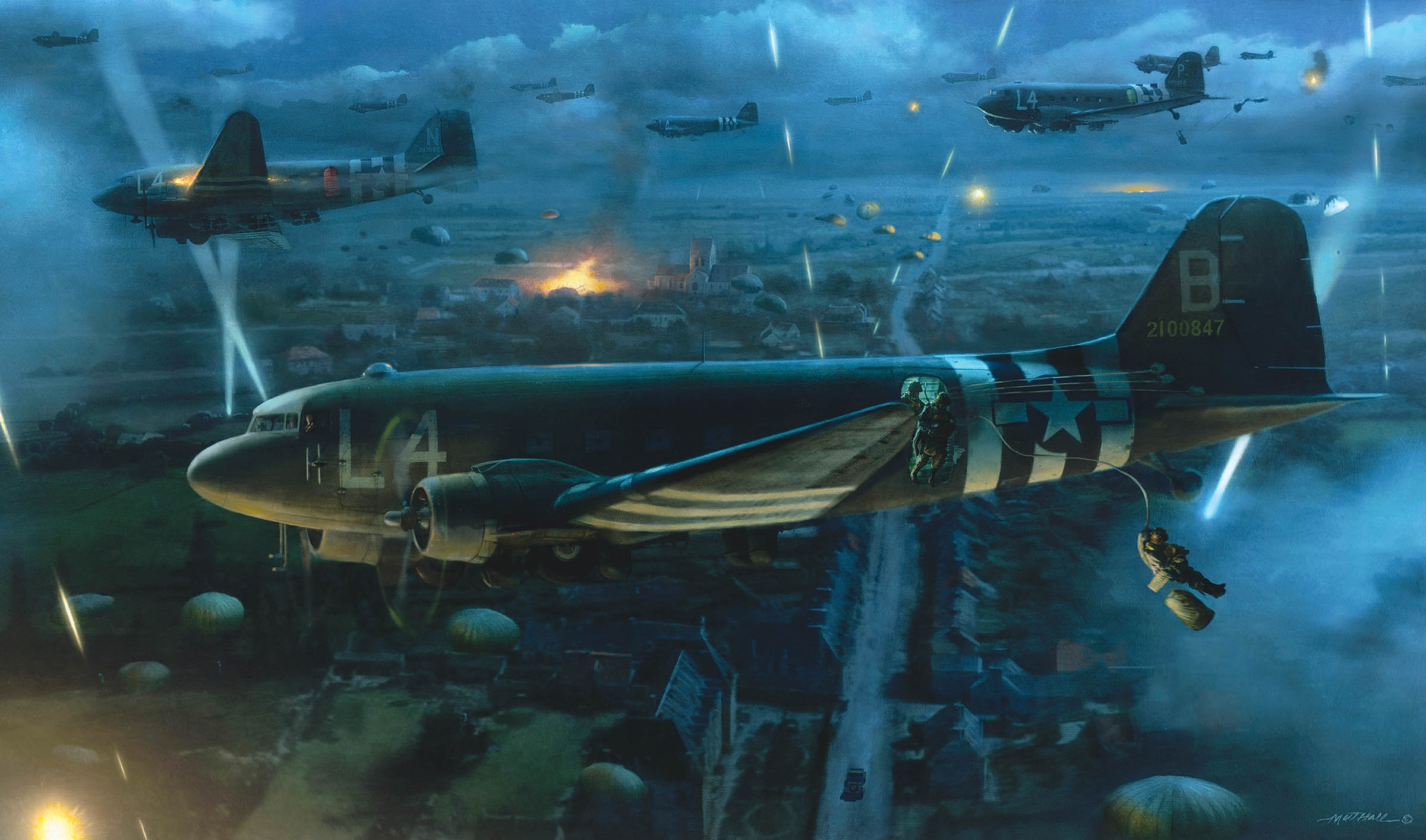On the eve of D-Day 75 years ago, two U.S. Army colonels made a bet. Lieutenant Colonel Charles Young, 39-year-old commander of the Ninth Air Force’s 439th Troop Carrier Group, was confident that he could put the paratroopers of his “lift” within 300 yards of the desired landing zone in Normandy. Colonel Robert Sink, who led the 506th Parachute Infantry Regiment (PIR) of the 101st Airborne Division, was skeptical. He took the bet: five British pounds.
That exchange during the final briefing for Operation Overlord represented the intimate relationship between the Army Air Forces’ Troop Carrier Command and the airborne soldiers TCC delivered to drop zones around the world.
If any World War II combat aviation unit remains unappreciated to this day, it’s Troop Carrier Command. While the Marine Corps’ “Black Sheep,” the AAF’s Tuskegee Airmen and the Women Airforce Service Pilots continue to receive accolades, TCC’s war-winning contribution is largely overlooked. Yet Troop Carrier Command fought a truly global war, and the numbers are remarkable: about 30 major combat operations by 21,800 paratroopers, not counting glider infantry or OSS agents.
TCC’s workhorse was the Douglas C-47 Skytrain, including about 380 C-53 Skytrooper personnel transports. A typical Skytrain combat load was 18 to 22 paratroopers, while C-53s accommodated 28 soldiers. Derived from the legendary 1935 DC-3 airliner, the “Gooney Bird” remains one of history’s most significant aircraft.
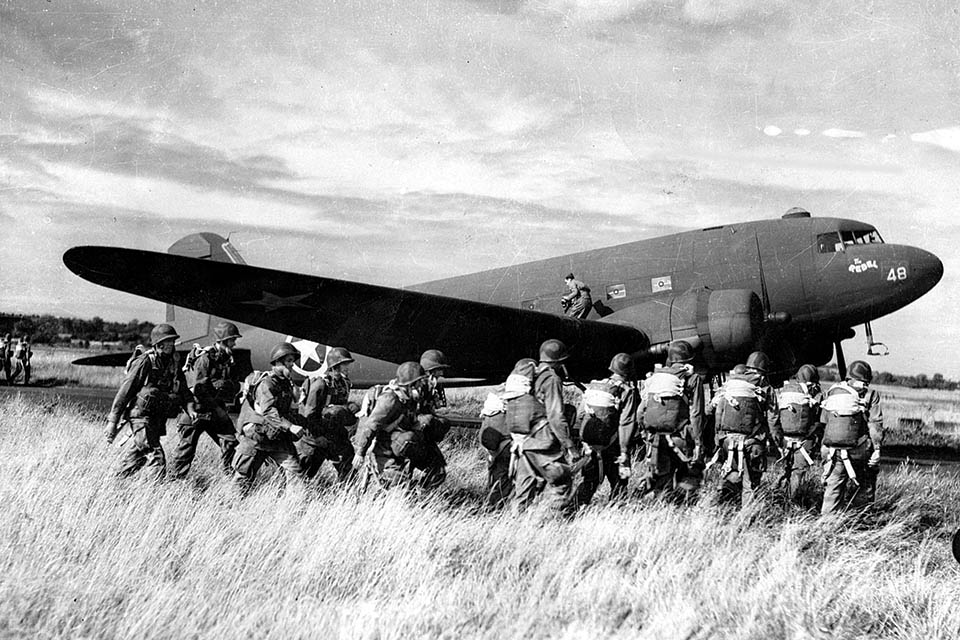
The U.S. Army formed a test parachute unit in May 1940 but did not establish TCC for two years. Though separate from Air Transport Command, TCC also ferried aircraft and delivered supplies alongside ATC throughout the war. Nonetheless, TCC quickly developed doctrine and methods to deliver airborne infantry behind enemy lines. Paratroopers were only half the equation, however, as equipment, procedures and tactics for towing gliders also were developed.
America’s first three airborne operations were flown during November and December 1942 to Morocco, Algeria and Tunisia, involving 938 jumps by the 509th PIR. The first two North African drops were classic airborne airfield seizures, while the third, involving just 32 men, blew up an important bridge. From there, troop carrier assignments grew in scope and size.
In July 1943 the Allies launched Operation Husky, the invasion of Sicily. On the night of July 9, elements of the 82nd Airborne Division aboard 226 Skytrains launched from Tunisia to secure roads and high ground inland from the port of Gela. It was the first major airborne operation ever mounted by U.S. armed forces, and the 2,700 troopers encountered serious problems. Because of navigation errors and high winds, parachutists were scattered along 50 to 60 miles of coastline, and only part of one battalion landed near its objective. Nonetheless, the outnumbered sky soldiers held on until relieved.
On the 10th the U.S. and Royal navies landed some 170,000 troops to seize the vital island dominating the central Mediterranean. Luftwaffe aircraft attacked the invasion fleet, sinking three vessels and setting sailors’ nerves on edge. The Navy gunners tended to shoot at any airplanes in sight, with poor command and control.
GET HISTORY’S GREATEST TALES—RIGHT IN YOUR INBOX
Subscribe to our HistoryNet Now! newsletter for the best of the past, delivered every Monday and Thursday.
Because Gela had been secured, the drop originally scheduled for July 10 was postponed until the night of July 11. Allied air commanders had already issued warnings to their naval counterparts, alerting ships to the change in schedule.
But, as seems inevitable in the military, some people did not get the word. And to complicate matters, the Luftwaffe launched its heaviest effort against the task force shortly before midnight on the 11th, just ahead of the C-47s.
Inbound that night, observing radio silence while flying nine-plane V formations, 144 C-47s cruised at 400 feet, the preferred drop altitude. The first two formations flew the briefed course and dropped their troopers as planned on Sicily’s southern coasts.
As the following vees approached the beach, one nervous or uninformed gunner opened fire. Today’s phrase is “firing contagion.” Once a single shooter opens up, so does everybody.
It was a disaster.
A Coast Guardsman aboard the transport SS Leonard Wood said, “We shot down many planes but had no knowledge of whose they were.” The official AAF history concluded, “The slow-flying majestic columns…were like sitting ducks.” And like wingshot fowl, plane after plane coughed flame, came apart and dropped into the water.
Pilots faced drastic decisions: turn back, drop their troops prematurely or attempt a night ditching. Eventually eight C-47s succeeded in returning to Tunisia with soldiers safely aboard.
By the time the reckoning was completed, the ghastly toll included 23 transports shot down, crashed or ditched, with 318 troopers killed or wounded and 60 airmen dead. More than half the surviving C-47s sustained battle damage.
Theater commander General Dwight D. Eisenhower’s report noted, “[T]he briefed flight path followed the battle front for about 35 miles; and the anti-aircraft gunners on ship and shore had been conditioned by two days of air attack to shoot at sight.” Naval historian Samuel Eliot Morison wrote, “It seemed incredible that the Air Force would lay on so hazardous a flight at low level—over an assault area heavily committed in combat, where enemy raids had been frequent for two days—and for no sound purpose.”
Beneath a full moon on the night of June 5, 1944, the Skytrains climbed away from the English coast, southbound for Normandy. Ninth Air Force troop carrier strength had grown dramatically in six months: from fewer than 250 crews in January 1944 to 1,115 in May.
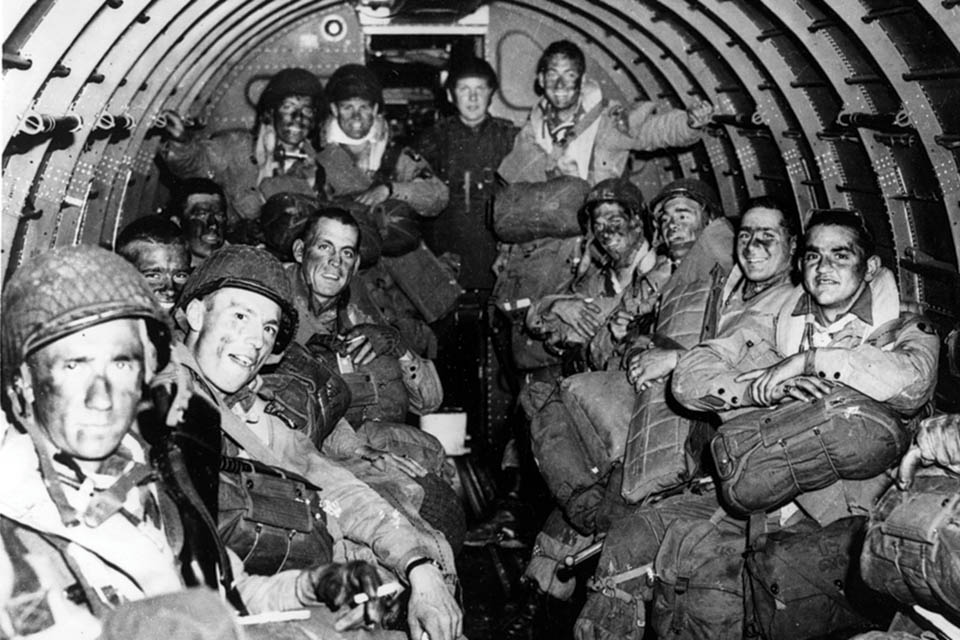
In its combat debut, IX Troop Carrier Command had about 1,200 transports and 1,400 gliders to deliver the 82nd and 101st Airborne divisions on D-Day. The lifters represented 14 groups, each with four squadrons. In all, the Americans and British delivered about 24,000 troopers by transports and gliders.
Weather was a problem. Cloud decks over the Channel and France obscured checkpoints, and coastal fog blocked many drop zones. Nonetheless, Skytrain crews pressed ahead, many encountering lethal flak. Approaching its DZ, the 435th Group had three planes blown apart within minutes.
Meanwhile, Colonel Bob Sink’s 506th PIR jumped into Drop Zone C about four miles inland. Lieutenant Colonel Young and the 14 Skytrains of his serial put nearly all their troopers on target—one snagged a tree behind the house designated as Sink’s command post.
One of Young’s navigators, Lieutenant Robert Dains, recalled: “Our group put up an 81-ship formation for the mission. We were the 79th plane. I had a pretty good view of the show up ahead. When we crossed the French coast we encountered a cloud deck. Some planes went above the clouds. We stayed below so I could see the checkpoints to hit the drop zone. Suddenly there were paratroopers in the air all around us. A plane above the clouds had dropped his troopers. Thank God we didn’t hit any.
“A machine gun position directly ahead began firing at the flight ahead of us. He hit the lead plane; it nosed up, its landing lights flashing, and fell off on the left wing, crashing in a ball of fire on the ground. All I could see protruding from the fireball were wing tips and empennage.
“Then our time came to come under fire from the machine gun position. He was firing green tracers and was walking them back toward our plane. They were coming up the right side of the plane. I thought we were going to get it. The copilot threw up his arms to protect himself. I had a flak helmet and flak suit on. I ducked my head down, waiting for the impact. The tracers were so close they lit up the cockpit with a green flow, then stopped. We didn’t get a scratch. Another second and the shells would have penetrated the gas tanks. I wouldn’t be here to tell this story.”
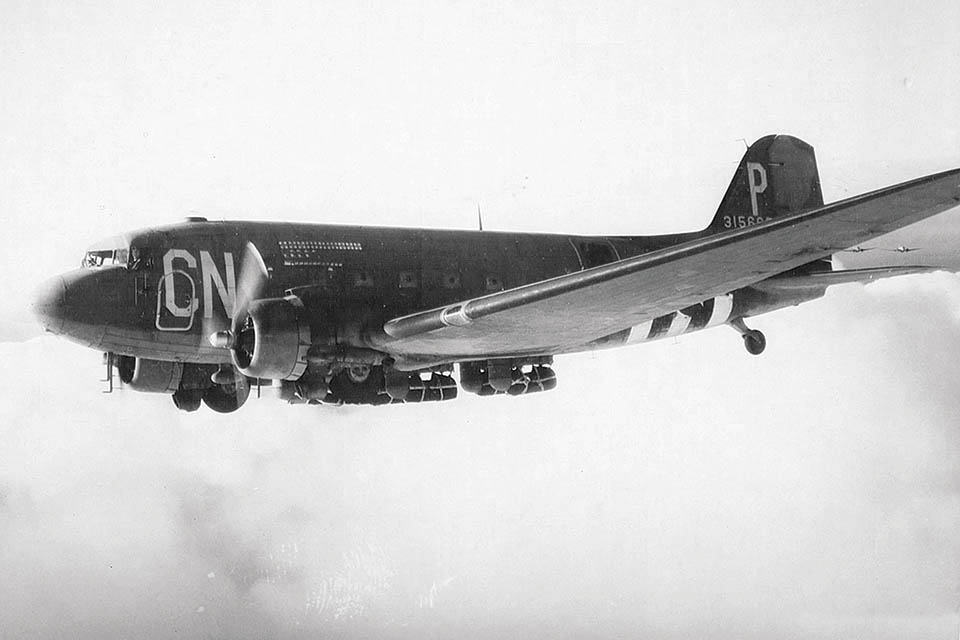
Eleven of the U.S. TCC groups lost 20 aircraft, including four of Lt. Col. Young’s 439th Group. However, after the 506th Infantry returned to England in July, an officer appeared at the 439th’s field at Upottery. Because most of Sink’s command element had landed within 200 yards of the goal, the paratrooper handed Young a £10 note from Bob Sink—twice the amount of the bet.
Troop carriers also contributed to Operation Dragoon, the Allied invasion of southern France on August 15, 1944. Three TCC wings with 396 planes from Italy delivered some 5,600 troopers into the Riviera, surely the most glamorous venue of the war. The drop included a parachute regiment, two independent battalions and a glider infantry battalion plus artillery and engineers. The Americans also carried the British 2nd Parachute Brigade, with three battalions. Despite overcast and fog, the C-47 crews delivered their cargos accurately. The airborne force subsequently covered Seventh Army’s right flank while driving on Nice, secured at month’s end.
Three months after D-Day, Operation Market Garden was supposed to shorten the European war. But the September 17-25 air-ground assault into Holland encountered one snag after another, resulting in a bitter defeat for British Field Marshal Bernard Montgomery, who had organized the effort.
The First Allied Airborne Army lifted 36 battalions of infantry by 1,274 U.S. and 164 RAF C-47s and Dakotas, plus more than 3,100 gliders. But the transports could only deliver 60 percent of the ground forces in one mission. On the first day 90 percent of the Ninth Air Force planes dropped paratroopers, flipping to 90 percent gliders on the second day.
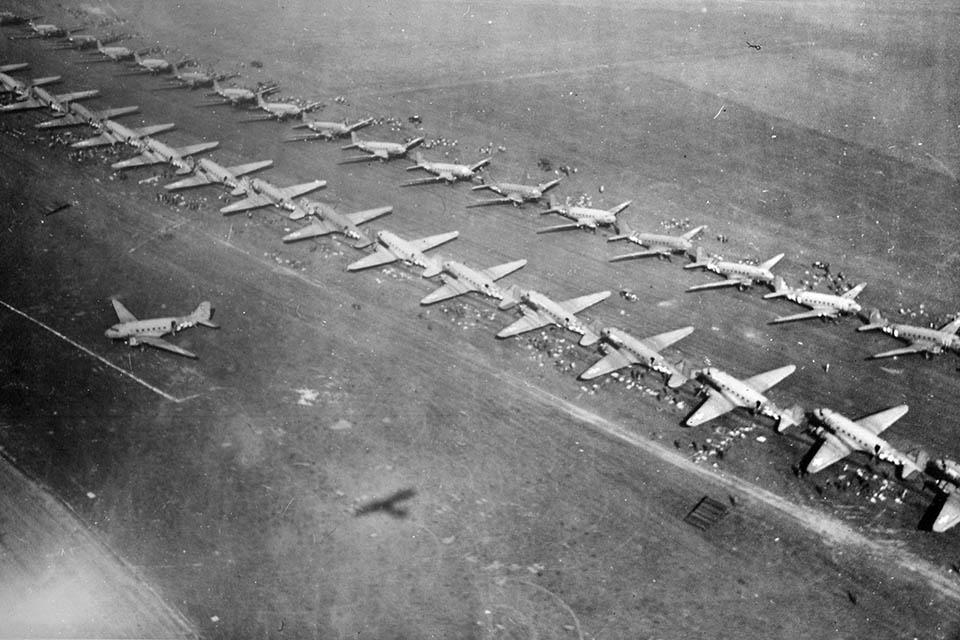
Troop Carrier Command delivered nearly 90 percent of its paratroopers within 1,000 yards of their drop zones, and 84 percent of the gliders. That record contrasted vividly with the drop at Normandy, where some troopers landed up to 12 miles off course.
Lieutenant Colonel Lawrence McMurtry of the 15th Troop Carrier Squadron, 61st Group, recounted: “We took off from Barkston Heath at 1150 hours. No difficulties were experienced as all planes easily assumed formation. Weather was excellent on the run in and return home—a factor that measured immeasurably in delivering our troops with minimum of inconvenience to them. Very few cases of sickness in flight were reported, and all airborne troops were dropped.
“The good weather conditions and adequate briefing enabled all planes to reach our DZ on schedule and very effective blue smoke positively identified our DZ. All aircraft—18 C-47s—reported dropping on the DZ.
“Heavy and light flak was experienced at four miles from the DZ. Several planes were hit and one had to be grounded when it reached home base. We suffered no casualties and all our aircraft returned by 1645 hours.
“Several planes experienced difficulties releasing supply bundles and radio silence was broken to inform these planes of their failure to release. One aircraft made a second pass but the bundle would not release. Ten bundles were returned. Cause of the trouble was: inexperience in attachment of bundles on the part of the airborne troops.”
TCC lost 27 C-47s on the first day and 17 on the second, with 21 more lost through the 25th—a total of 65 transports. But those losses were sustainable, and operations continued.
After Overlord and Market Garden, airborne commitments expanded. By 1945 the strength of a troop carrier group’s four squadrons was 80 to 110 aircraft, with 128 crews among 1,837 personnel.
The Rhine was the prize on March 24, 1945, as the Allies launched Operation Varsity, crossing into Germany. Airborne forces were committed to secure bridges and areas on the east bank around Wesel while amphibious units crossed over. However, nine months after D-Day, the Allies still lacked enough airlift. Consequently, the U.S. 13th Airborne Division was dropped from the plan, and the operation proceeded with the 17th (9,400 men) and the British 6th (7,200 men). The total airlift constituted more than 1,600 transports and 1,300 gliders.
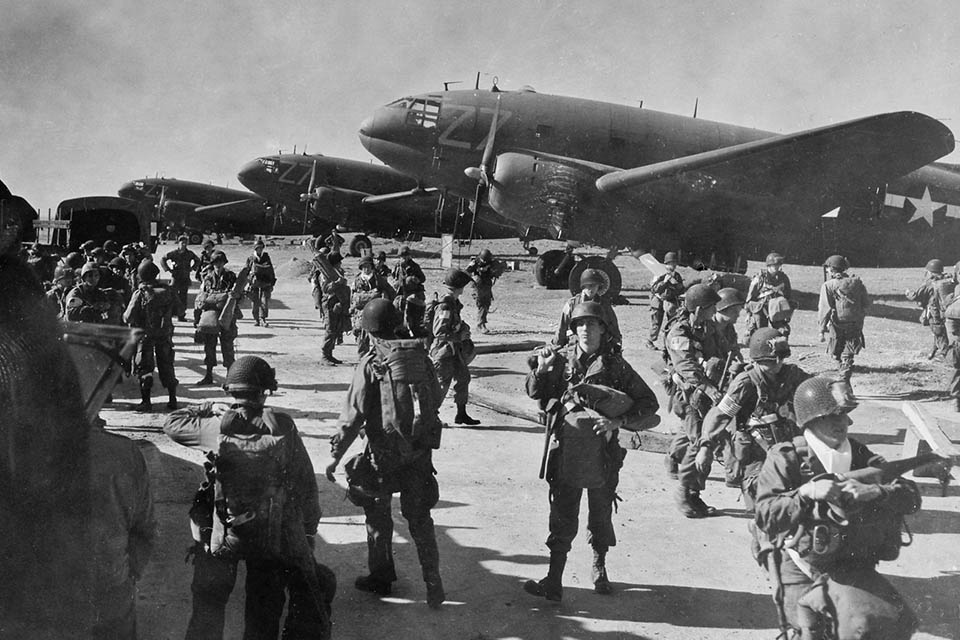
The TCC groups operated near Paris, where the 17th Division was camped. Wesel, the target area, lay 270 miles northeast. The 17th was lifted in part by 226 C-47s and 72 new Curtiss C-46 Commandos towing more than 900 gliders, while 750 RAF Dakotas towed another 420 gliders. Coordination was important: Most U.S. serials cruised at 140 mph, passing under Dakotas towing Airspeed Horsa gliders at 115 mph.
Varsity was the first European operation for the C-46, and the last. Though bigger and faster than the C-47, with superior altitude (irrelevant to airborne ops), the Commando was maintenance intensive, with a succession of post-production modifications from the trouble-plagued Curtiss company. Lieutenant Colonel William Filer’s 313th Troop Carrier Group was the only unit to fly C-46s in ETO combat.
Almost 900 U.S. fighters swept the region, establishing air superiority. Meanwhile, observers on the ground noted that the procession extended almost 200 miles, taking 2½ hours to pass overhead.
Unlike most previous airborne operations, in Varsity the troop carriers flew at low level in daylight, within range of German light and medium anti-aircraft guns. Anticipating battle damage, many C-47s were retrofitted with self-sealing fuel tanks, but the C-46s retained standard equipment. That probably accounted for the heavy C-46 losses: 19 of 72 Commandos, more than one in four.
Captain Victor Anderson of the 61st Troop Carrier Group carried 16 British troopers in his Skytrain. “It was after completing my second pass at the DZ and on my turn to the left…that I received concentrated small arms fire,” he remembered. “One of the shells penetrated the cockpit on the right side and shot out a gauge, releasing hydraulic pressure. The point of penetration was to the right and below the copilot’s seat. Before takeoff, the copilot, 2nd Lt. James A. Oien, and I noticed two extra flak suits in our aircraft. We used them to improvise additional armor by placing them under the seats and the two sides of the cockpit. It was that portion of the flak suit that Lt. Oien placed to the right of his seat and next to the side of the cockpit that ultimately stopped the shell, thus preventing a possible casualty. The shell was recovered and shows to be a German .30-caliber.” Landing in France, Anderson’s crew found hits in the elevator, rudder, belly and creased main gas lines.
In addition to the 19 Commandos lost by the 313th Group, the 315th wrote off seven Skytrains. In all, 30 U.S. transports were lost from nine groups. Varsity remains the largest single-drop airborne operation of all time, delivering 16,600 sky soldiers in transports and gliders.
Given the island-hopping nature of the Pacific War, airborne operations were essential to supporting Allied amphibious landings. The first Pacific operation of note occurred in New Guinea on September 5, 1943. General Douglas MacArthur provided a battalion of the 503rd PIR to seize Nadzab ahead of an Australian brigade en route to capturing the strategic Markham Valley. The 317th Troop Carrier Group had trained with the 503rd PIR in Australia, forming a strong team. Flying in daylight, the 317th contributed 24 of the 84 aircraft, leading elements of the 375th and 403rd groups. Captain Herbert Waldman, a 24-year-old statistician from New York, reported looking down the runway at Port Moresby and seeing “Skytrains as far as the eye could see—an amazing sight!”
Weather delayed takeoff, but at length the procession crossed the Owen Stanley Range beneath an umbrella of P-38s, P-39s and P-47s, while B-25s and A-20s prepared to suppress Japanese defenses. Douglases droned over the target at 400 feet, slowing from 155 to 100 mph.
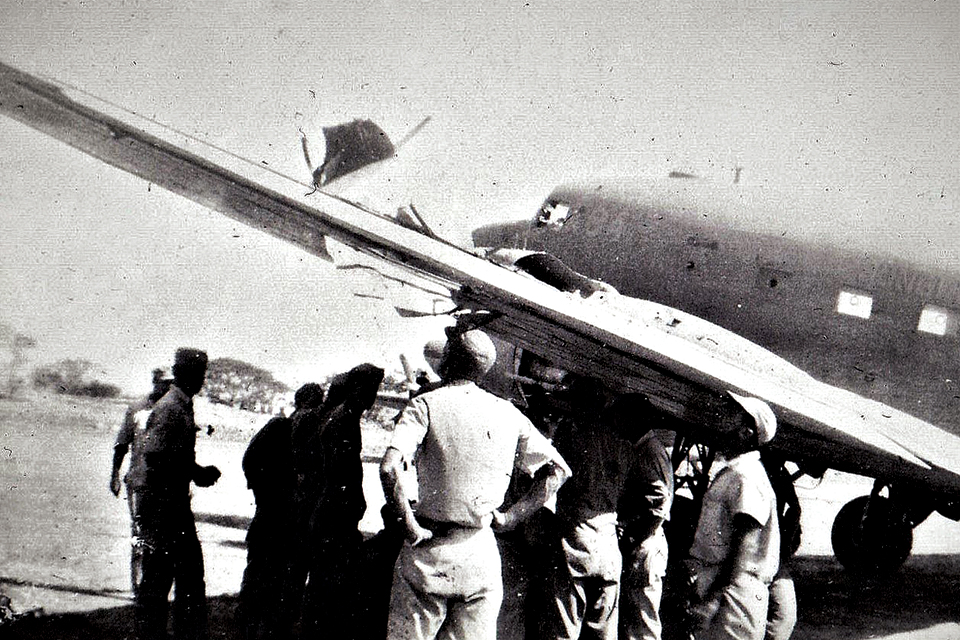
Maintaining tight formations, the aircrews delivered a concentration of 1,700 paratroopers into Nadzab’s tall grass. There was no opposition from enemy aircraft or AA guns. MacArthur observed the drop and messaged, “Gentlemen, that was as fine an example of discipline and training as I have ever witnessed.”
The next significant Pacific airborne op came 10 months later at Noemfoor Island off New Guinea’s northwest coast. On July 3-4, 1944, troop carriers delivered two battalions of the 503rd PIR in Operation Table Tennis, reinforcing amphibious forces already ashore.
Japan had owned the Philippine Islands since May 1942, but the archipelago remained a vital U.S. interest. American forces returned to the Philippines in overwhelming strength in October 1944, with combat lasting into June 1945. A small but important objective was Corregidor Island near the entrance to Manila Bay.
The veteran 317th “Jungle Zippers” delivered troopers into Corregidor’s two square miles, a challenging terrain with ravines and 500-foot cliffs. Planners selected two small drop zones, each assigned two troop carrier squadrons.
Fifty-one Skytrains of the 317th delivered 2,000 troopers in four waves on February 16 and 17, 1945. Owing to the extremely small targets, transports only dropped six to eight troopers per pass to keep them concentrated on the ground. Thus, most planes made three passes through groundfire to complete delivery.
Half the aircraft took hits, and despite the low drops, 12 troopers were killed in their chutes. But the mission succeeded, with Corregidor secured 10 days later.
Troop Carrier Command stood down in late 1945, but airborne assault operations continued in the Korean War. Transport planes flew 19 missions totaling 7,000 jumpers, with two major operations in 1950 and 1951.
During the Cold War the troop carrier mission passed to Air Mobility Command. Today it belongs to Air Combat Command, heir to a historic legacy seven decades old.
Frequent contributor Barrett Tillman is the author of more than 40 books on military history, including D-Day Encyclopedia. Further reading: Into the Valley: The Untold Story of USAAF Troop Carrier in World War II, by Col. Charles H. Young; and World War II Army Airborne Troop Carriers, by David Polk.
This feature originally appeared in the July 2019 issue of Aviation History. Subscribe here!

